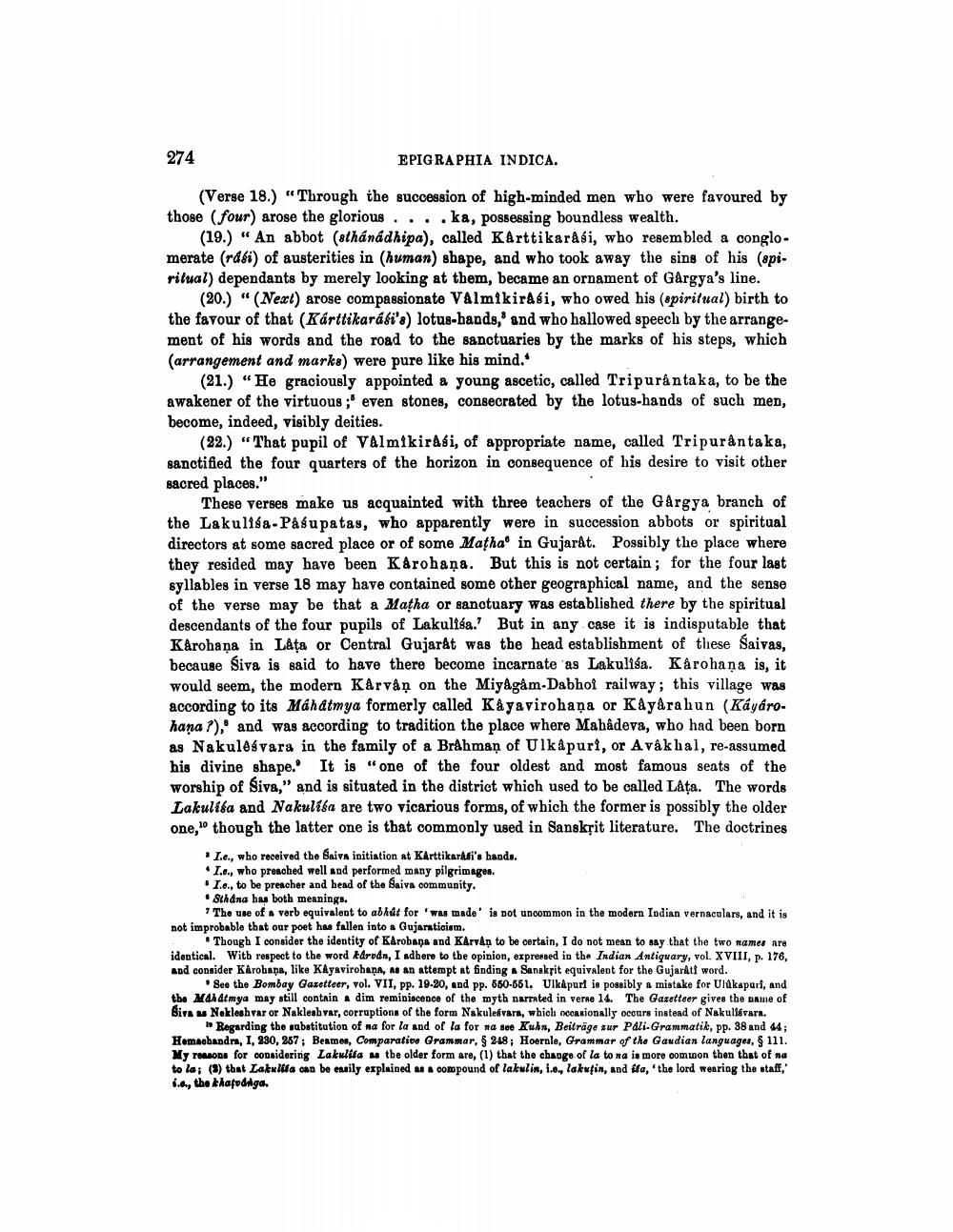________________
274
EPIGRAPHIA INDICA.
(Verse 18.) “Through the succession of high-minded men who were favoured by those four) arose the glorious ....ka, possessing boundless wealth.
(19.) "An abbot (sthanadhipa), called Karttikarasi, who resembled a conglomerate (rdéi) of austerities in (human) shape, and who took away the sins of his (spiritual) dependants by merely looking at them, became an ornament of Gárgya's line.
(20.) " (Next) arose compassionate Valmikirasi, who owed his spiritual) birth to the favour of that (Karttikaráfi's) lotus-hands, and who hallowed speech by the arrangement of his words and the road to the sanctuaries by the marks of his steps, which (arrangement and marks) were pure like his mind."
(21.) “He graciously appointed a young ascetic, called Tripuråntaka, to be the awakener of the virtuous;' even stones, consecrated by the lotus-hands of such men, become, indeed, visibly deities.
(22.) “That pupil of Valmikirasi, of appropriate name, called Tripurântaka, sanctified the four quarters of the horizon in consequence of his desire to visit other sacred places."
These verses make us acquainted with three teachers of the Gargya branch of the Lakulisa-Pasupatas, who apparently were in succession abbots or spiritual directors at some sacred place or of some Matha in Gujarat. Possibly the place where they resided may have been Karohana. But this is not certain; for the four last syllables in verse 18 may have contained some other geographical name, and the sense of the verse may be that a Matha or sanctuary was established there by the spiritual descendants of the four pupils of Lakulisa. But in any case it is indisputable that Karohaņa in Lata or Central Gujarat was the head establishment of these Saivas, because Siva is said to have there become incarnate 'as Lakulisa. Karohana is, it would seem, the modern Kårvån on the Miyagam-Dabhoi railway; this village was according to its Mahatmya formerly called Kayavirohaņa or Kayåra hun (Káyárohana ?), and was according to tradition the place where Mahadeva, who had been born as Nakulesvara in the family of a Brahman of Ulkápuri, or Avakhal, re-assumed his divine shape. It is one of the four oldest and most famous seats of the worship of Siva," and is situated in the district which used to be called Laţa. The words Lakulića and Nakulisa are two vicarious forms, of which the former is possibly the older one, though the latter one is that commonly used in Sanskrit literature. The doctrines
* I.e., who received the Saiva initiation at Karttikarási's hands. • I.o., who preached well and performed many pilgrimages.
I.o., to be preacher and bead of the Saiva community. • Sthana has both meanings.
* The use of a verb equivalent to abhut for 'was made is not uncommon in the modern Iodian vernaculars, and it is not improbable that our poet has fallen into a Gujaraticism.
. Though I consider the identity of Karobana and KArvån to be certain, I do not mean to say that the two names are identical. With respect to the word Adrodn, I adhere to the opinion, expressed in the Indian Antiquary, vol. XVIII, p. 176, and consider Kårobana, like Kayavirohana, As an attempt at finding & Sanskrit equivalent for the Gujarati word.
See the Bombay Gazetteer, vol. VII, pp. 19-20, and pp. 550-561. Ulkápurt is possibly a mistake for Uldkapari, and the Mahatmya may still contain a dim reminiscence of the myth narrated in verse 14. The Gazetteer gives the name of Siva u Nokleshvar or Naklesbyar, corruptions of the form Nakulesvara, which occasionally occurs instead of Nakuliávara.
Regarding the rabatitation of na for la and of la for na see Kuhn, Beiträge zur Pdli-Grammatik, pp. 38 and 14; Homachandra, I, 230, 257; Bermes, Comparative Grammar, $ 248; Hoernle, Grammar of the Gandian languages, $ 111. My Mons for considering Lakulua n the older form are, (1) that the change of la to na is more common then that of na to la; (3) that Lakuuta can be easily explained as a compound of lakulir, i.e., laluţin, and a, 'the lord wearing the staff," 1.o, the khatodiga.




